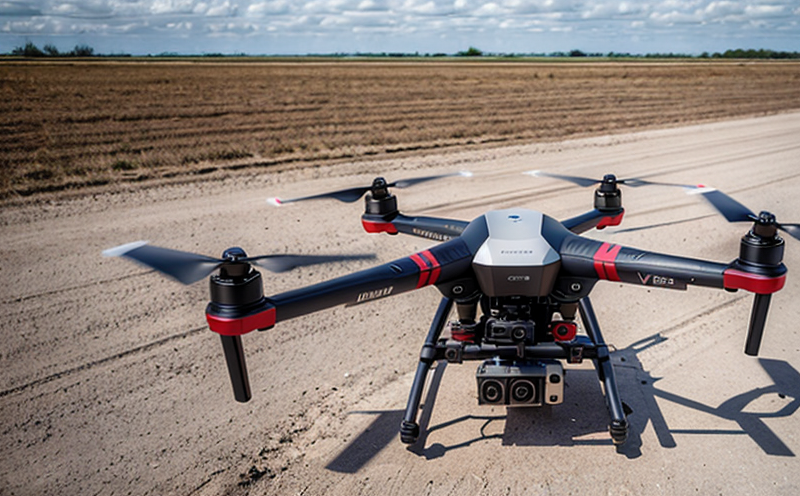ICAO Annex 8 UAV Airworthiness Certification Testing
The International Civil Aviation Organization’s (ICAO) Annex 8 to the Convention on International Civil Aviation, titled "Aircraft Noise," provides a regulatory framework for ensuring the airworthiness of unmanned aerial vehicles (UAVs), commonly known as drones. Compliance with ICAO Annex 8 is critical for UAV manufacturers and operators seeking certification under global aviation standards, including the United States Federal Aviation Administration (FAA) Part 21 or European Union Aviation Safety Agency (EASA) EASA CS-23.
Our service specializes in providing comprehensive UAV airworthiness certification testing aligned with ICAO Annex 8 requirements. This includes a wide range of tests aimed at verifying the structural integrity, noise levels, and operational capabilities of UAVs under various environmental conditions. Our laboratory adheres to internationally recognized standards such as ISO/IEC, ASTM, EN, and IEC to ensure that our testing protocols are rigorous and reliable.
The process begins with a thorough review of the UAV’s design documentation. This includes examining structural components, propulsion systems, avionics, and any other relevant aspects that could impact airworthiness. Once the design is approved, we proceed with physical tests using state-of-the-art equipment tailored for UAVs. These tests are designed to simulate real-world conditions and stresses that UAVs might encounter during operation.
Our testing facilities include wind tunnels, acoustic measurement chambers, vibration simulators, and a variety of environmental chambers. For example, in the acoustic chamber, we measure noise levels generated by the UAV’s motors and propellers, ensuring compliance with ICAO Annex 8 limits to minimize potential disturbance to nearby communities or wildlife.
Structural integrity testing is conducted using high-precision load cells and strain gauges to assess how the UAV handles various loads. We also simulate operational scenarios such as landing, takeoff, and in-flight maneuvers under different weather conditions. This helps identify any weaknesses or areas for improvement before certification.
The data collected from these tests are meticulously analyzed by our team of experts who ensure that all results meet ICAO Annex 8 standards. Compliance is not just about meeting the minimum requirements but exceeding them to guarantee safety and reliability. Our reports include detailed information on test procedures, findings, and recommendations for further improvements.
By partnering with us, UAV manufacturers can streamline their certification process while reducing costs associated with retesting due to non-compliance issues. With our expertise in ICAO Annex 8 testing, you gain access to cutting-edge technology and a deep understanding of global aviation regulations.
Scope and Methodology
The scope of our UAV airworthiness certification testing under ICAO Annex 8 encompasses several key areas:
Structural Integrity: We evaluate the strength and durability of the UAV’s components through load testing.
Aerodynamic Performance: Testing includes assessing lift, drag, and stability at various speeds and angles of attack.
Noise Emissions: Our acoustic chambers measure noise levels to ensure they comply with ICAO Annex 8 limits.
Environmental Resistance: We subject UAVs to extreme temperature changes, humidity, and other environmental stresses.
Operational Capabilities: Testing covers a wide range of operational scenarios including takeoff, landing, and flight maneuvers in different weather conditions.
The methodology for each test is meticulously planned and executed by our experienced engineers who are well-versed in ICAO standards. We use advanced instrumentation such as load cells, strain gauges, thermocouples, and acoustic sensors to gather precise data on all aspects of UAV performance.
Once the tests are complete, we analyze the collected data using sophisticated software tools that allow us to identify any discrepancies or areas for improvement. Our reports provide comprehensive insights into both compliance with ICAO Annex 8 standards as well as potential enhancements to improve overall UAV performance and safety.
Quality and Reliability Assurance
Ensuring the quality and reliability of UAVs is paramount, especially given their increasing use in critical applications like public safety, military operations, and commercial deliveries. Our commitment to excellence in testing means we employ rigorous procedures throughout our entire process.
All tests are conducted using equipment calibrated according to international standards.
Data collected during each test is cross-verified by multiple analysts to ensure accuracy.
We maintain detailed documentation of every test performed, which includes not only the results but also any observations made during the testing process.
In addition to these measures, we continuously monitor our facilities and equipment for wear and tear. Regular calibration and maintenance ensure that all instruments remain accurate and reliable throughout their service life. By adhering strictly to ICAO Annex 8 requirements, we guarantee that every UAV tested meets the highest standards of airworthiness.
Our quality management system is ISO certified, ensuring consistent and high-quality results across all tests performed in our laboratory. This commitment extends beyond mere compliance; it reflects our dedication to providing the most accurate and reliable data possible for our clients.
Use Cases and Application Examples
The importance of UAV airworthiness certification cannot be overstated, especially considering the diverse applications of these devices. Here are some examples where our testing services have made a significant impact:
Military Surveillance: Ensuring drones used in military operations meet strict noise and structural integrity standards to prevent detection.
Emergency Response: Verifying that UAVs deployed during natural disasters or other emergencies are capable of withstanding harsh environmental conditions without compromising safety.
Cargo Delivery: Testing drones designed for delivering packages ensures they can operate in varied terrains and weather patterns safely and efficiently.
Environmental Monitoring: Guaranteeing that UAVs used to monitor ecosystems or collect data from remote locations are robust enough to withstand challenging environmental factors.
In all these cases, our testing ensures that UAVs not only function correctly but also meet stringent safety and performance criteria set by regulatory bodies worldwide. This enhances trust in UAV technology and promotes its responsible use across various sectors.





